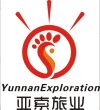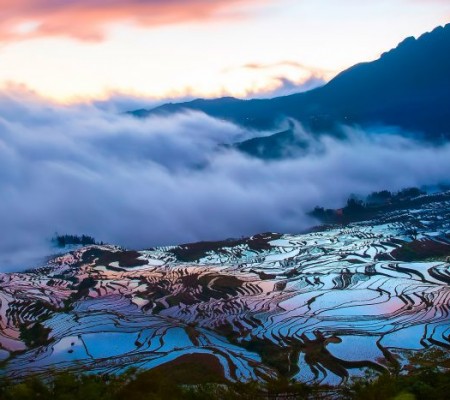
Ezha Town of Yuanyang County in Honghe Prefecture
Ezhaxiang (俄扎乡) is located in the southwest of Yuanyang County (元阳县), within Honghe Hani and Yi Autonomous Prefecture (红河哈尼族彝族自治州), Yunnan Province (云南省). It lies in the southern section of the Ailao Mountains (哀牢山) on the southern bank of the Red River (红河). It borders Ganiangxiang (嘎娘乡) and Shangxincheng Township (上新城乡) to the east, Huangmaolingxiang (黄茅岭乡) to the south, and is separated from Lvchun County (绿春县) by the Xiaoheijiang River (小黑江) to the west. To the north, it is adjacent to Xinjie Town (新街镇). The terrain is high in the northwest and low in the southeast, primarily mountainous with ridges and valleys. The highest elevation is 2,580 meters and the lowest is 400 meters, resulting in a distinct vertical climate. Thanks to this unique geography, Ezhaxiang is rich in natural resources and diverse ethnic cultures, making it a hidden gem in Yuanyang County.
History and Culture
Ezhaxiang (俄扎乡) has a long history and is home to several ethnic groups, including the Hani (哈尼族) and Yi (彝族) peoples, with the Hani culture particularly prominent. As an ancient agrarian civilization, the Hani have cultivated the land here for thousands of years, creating the world-renowned terraced farming system. Many traditional buildings and customs are well-preserved in the Hani villages of Ezhaxiang, serving as a vital channel for cultural inheritance. The local people live in harmony with the terraced landscapes, reflecting their deep reverence for nature and a lifestyle that blends seamlessly with the environment.
Local Customs
Traditional Festivals
One of the most important festivals in Ezhaxiang is the Hani “Angmatu Festival” (昂玛突节). During this time, villagers dress in traditional clothing and hold grand sacrificial ceremonies to pray for good weather and bountiful harvests. Pigs and cattle are slaughtered, and offerings are placed on the altar. The ceremony is presided over by respected village elders and is solemn and sacred. Afterward, a communal feast known as the “long street banquet” is held. Families line up dishes on long tables, and everyone sits together to share food and toast each other, creating a lively and joyful atmosphere.
Traditional Music and Dance
Both the Hani (哈尼族) and Yi (彝族) peoples of Ezhaxiang have vibrant traditions of music and dance. The Hani “Lezuo Dance” (乐作舞) is a highly representative group dance, where participants form a circle and dance rhythmically to drums and lusheng (芦笙) music. The steps are light and lively, showcasing the Hani people’s zest for life. The Yi “Smoke Box Dance” (烟盒舞) is another unique performance where dancers use smoke boxes to produce crisp sounds while performing expressive dance movements, combining grace with strength.
Traditional Handicrafts
The local craftsmanship is exquisite. The Hani are known for their colorful embroidery featuring nature-inspired and mythological motifs, used on garments, handkerchiefs, and shoulder bags. The Yi are skilled in bamboo weaving, creating elegant and practical items like baskets, stools, and chairs, all reflecting their ingenuity and hardworking spirit.
Climate and Best Time to Visit
Ezhaxiang has a subtropical mountainous monsoon climate—warm and humid year-round—with distinct vertical climate changes due to elevation differences. The best time to visit is from November to April, during the dry season. During this time, the weather is sunny and the water-filled terraces shimmer under the sunlight, creating a spectacular kaleidoscope of colors. Around Chinese New Year, visitors can also experience Hani festivals and immerse themselves in local traditions and celebrations.
Recommended Attractions and Visiting Duration
Ezhaxiang Rice Terraces
The grand and majestic Ezhaxiang Rice Terraces are a key part of Hani terrace culture. At sunrise, the first golden rays reflect on the water, and mist swirls around, creating a dreamlike scene. Recommended visiting time: 2–3 hours. Walk along the ridges for close-up views or head to the best viewing platforms for sunrise photography.
Pujia Ethnic Village
Pujia is a well-preserved Hani village with traditional “mushroom houses” scattered across the hills. Visitors can tour traditional homes, observe daily life, and appreciate local handicrafts like embroidery and bamboo weaving. Recommended visiting time: 1–2 hours for a deep dive into rural Hani life.
Habo Rice Terraces and Habo Village
Though administratively part of Xinjie Town (新街镇), Habo Village is near Ezhaxiang and worth visiting. The terraces here form a spectacular landscape resembling a giant painting when viewed from above. The village preserves ancient Hani traditions and hosts vibrant festivals. Recommended visiting time: 2–3 hours, including both the terraces and cultural experience.
Transportation
Getting to Ezhaxiang
By Air
Fly to Mengzi Airport (蒙自机场), which is about 130 km from Yuanyang County (元阳县). From the airport, take a shuttle bus to Yuanyang (2–3 hours). Private car hire is faster but more expensive.
By Train
Take a train to Jianshui Station (建水站), then transfer to Jianshui Bus Station to catch a bus to Yuanyang. Buses are frequent, and the ride takes about 2 hours.
Local Transportation
Once in Yuanyang, take a minibus from the county’s bus terminal to Ezhaxiang (俄扎乡). These buses are less frequent, so it’s wise to check schedules in advance. Alternatively, you can take a taxi or local van, which is more convenient but pricier. For getting around Ezhaxiang itself, renting a motorcycle or taking local shuttle vehicles is a practical choice.
Local Cuisine
Red Rice from the Terraces
The red rice grown in Ezhaxiang’s terraced fields is rich in minerals and nutrients. It has a fragrant aroma and a soft, sticky texture. It’s also used in local snacks like red rice cakes, which are sweet and flavorful.
Terrace Fish
Raised in the terrace water, these fish are tender and odorless. They are commonly steamed, braised, or cooked with pickled bamboo shoots. Steamed fish preserves the natural sweetness, while braised fish is rich in flavor. The pickled bamboo shoot fish dish is spicy and sour, a local favorite.
Hani Dipping Chicken
Made from local free-range chickens, the meat is juicy and tender. The dish is served with a spicy dipping sauce made from chili, Sichuan peppercorns, ginger, garlic, and cilantro. It’s flavorful and appetite-boosting.
Bamboo Tube Rice
Sticky rice is packed into fresh bamboo tubes with water and ingredients like red dates or sweet bean paste, then grilled over a fire. The result is aromatic, soft, and sweet rice with a distinct bamboo fragrance.
Shopping
Hani Embroidery Handicrafts
Available at local markets or from villagers, Hani embroidery is colorful and intricately designed with strong ethnic characteristics—ideal as souvenirs or gifts.
Red Rice and Red Rice Products
Bring home some red rice to share the local flavor. Other options include red rice cakes and red rice wine.
Yi Bamboo Woven Goods
Beautiful and practical baskets, stools, and other items made by the Yi people are excellent, locally flavored souvenirs.
Specialty Agricultural Products
Local specialties like black fungus, shiitake mushrooms, and honey are all natural, high-quality, and chemical-free—great gift options.
Accommodation
Guesthouses in Ezhaxiang
Ezhaxiang offers family-run guesthouses that are affordable and provide an authentic rural experience. Rooms are clean and some guesthouses also serve local cuisine.
Hotels in Xinjie Town
Xinjie Town (新街镇) is close to Ezhaxiang and has more accommodation choices, from budget hotels to comfortable inns. Facilities are more complete and transportation is convenient.
Hotels in Yuanyang County Seat
For higher-end accommodations, stay in Yuanyang’s county seat. There are star-rated hotels with better service and amenities, but plan travel time to and from Ezhaxiang accordingly.
Travel Tips
Respect Local Customs
Ezhaxiang is home to multiple ethnic minorities. Visitors should respect local customs and religious practices.

 7 Days GolfingTour
7 Days GolfingTour
 8 Days Group Tour
8 Days Group Tour
 8 Days Yunnan Tour
8 Days Yunnan Tour
 7 Days Shangri La Hiking
7 Days Shangri La Hiking
 11 Days Yunnan Tour
11 Days Yunnan Tour
 6 Days Yuanyang Terraces
6 Days Yuanyang Terraces
 11 Days Yunnan Tour
11 Days Yunnan Tour
 8 Days South Yunnan
8 Days South Yunnan
 7 Days Tea Tour
7 Days Tea Tour
 8 Days Muslim Tour
8 Days Muslim Tour
 12 Days Self-Driving
12 Days Self-Driving
 4 Days Haba Climbing
4 Days Haba Climbing
 Tiger Leaping Gorge
Tiger Leaping Gorge
 Stone Forest
Stone Forest
 Yunnan-Tibet
Yunnan-Tibet
 Hani Rice Terraces
Hani Rice Terraces
 Kunming
Kunming
 Lijiang
Lijiang
 Shangri-la
Shangri-la
 Dali
Dali
 XishuangBanna
XishuangBanna
 Honghe
Honghe
 Kunming
Kunming
 Lijiang
Lijiang
 Shangri-la
Shangri-la
 Yuanyang Rice Terraces
Yuanyang Rice Terraces
 Nujiang
Nujiang
 XishuangBanna
XishuangBanna
 Spring City Golf
Spring City Golf
 Snow Mountain Golf
Snow Mountain Golf
 Stone Mountain Golf
Stone Mountain Golf












